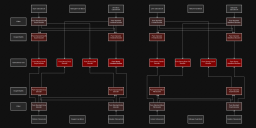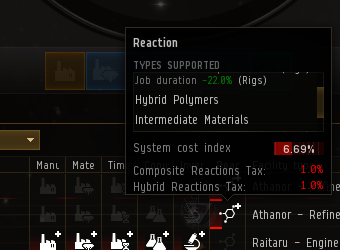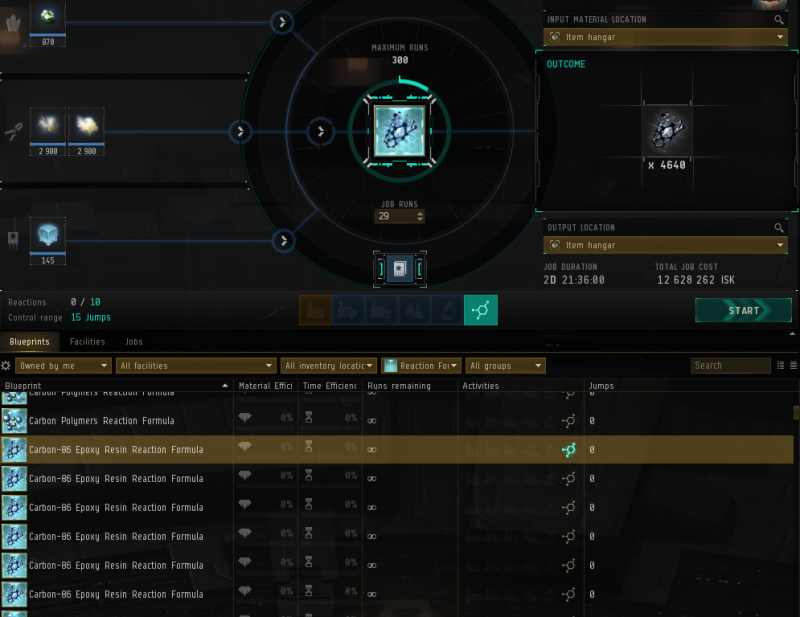No edit summary |
No edit summary |
||
| Line 148: | Line 148: | ||
* Step 4: Advanced components are then manufactured just like any other T1 manufacturing process, using composite materials as inputs. | * Step 4: Advanced components are then manufactured just like any other T1 manufacturing process, using composite materials as inputs. | ||
=== Intermediate Materials === | |||
Intermediate material reactions produce 200 units of product, consuming 100 units of each input required, plus 5 appropriate fuel blocks. Intermediate material reactions are organized as follows (note | Intermediate material reactions produce 200 units of product, consuming 100 units of each input required, plus 5 appropriate fuel blocks. Intermediate material reactions are organized as follows (note- the Unrefined variations are removed from this table): | ||
| Line 258: | Line 258: | ||
|Vanadium | |Vanadium | ||
|Hafnite | |Hafnite | ||
|- | |||
|} | |||
=== Composite Materials === | |||
Composite materials come in Amarr, Caldari, Gallente, and Minmatar flavours, with the icon coloured according to which race they 'belong' to. Like the other reactions, 100 units of each input are required, plus the appropriate 5 fuel blocks. However, the units produced varies, and some composite materials require three or four different intermediate inputs instead of the usual two. Composite reactions are organized as follows: | |||
{| class="wikitable" | |||
! style="background:#222222;" | Composite | |||
! style="background:#222222;" | Amount Produced | |||
! style="background:#222222;" | Fuel Block | |||
! style="background:#222222;" | Input | |||
! style="background:#222222;" | Input | |||
! style="background:#222222;" | Extra Input? | |||
! style="background:#222222;" | Extra Input? | |||
! style="background:#222222;" | Empire | |||
|- | |||
|{{icon|veldspar||Veldspar}} Crystalline Carbonide | |||
|10,000 | |||
|Helium | |||
|Crystallite Alloy | |||
|Carbon Polymers | |||
|- | |||
|- | |||
|Gallente | |||
|- | |||
| {{icon|scordite||Scordite}} Fermionic Condensates | |||
|200 | |||
|Helium | |||
|Caesarium Cadmide | |||
|Dysprosite | |||
|Fluxed Condensates | |||
|- | |||
|All | |||
|- | |||
| {{icon|pyroxeres||Pyroxeres}} Fernite Carbide | |||
|10,000 | |||
|Hydrogen | |||
|Fernite Alloy | |||
|Ceramic Powder | |||
|- | |||
|- | |||
|Amarr | |||
|- | |||
| {{icon|plagioclase||Plagioclase}} Ferrogel | |||
|400 | |||
|Hydrogen | |||
|Hexite | |||
|Hyperflurite | |||
|Ferrofluid | |||
|Prometium | |||
|All | |||
|- | |||
| {{icon|omber||Omber}} Fullerides | |||
|3,000 | |||
|Nitrogen | |||
|Carbon Polymers | |||
|Platinum Technite | |||
|- | |||
|- | |||
|All | |||
|- | |||
| {{icon|kernite||Kernite}} Hypersynaptic Fibers | |||
|750 | |||
|Oxygen | |||
|Vanadium Hafnite | |||
|Solerium | |||
|Dysprosite | |||
|- | |||
|All | |||
|- | |||
| {{icon|jaspet||Jaspet}} Nanotransistors | |||
|1,500 | |||
|Nitrogen | |||
|Sulfuric Acid | |||
|Platinum technite | |||
|Neo Mercurite | |||
|- | |||
|All | |||
|- | |||
| {{icon|hemorphite||Hemorphite}} Nonlinear Metamaterials | |||
|300 | |||
|Nitrogen | |||
|Titanium Chromide | |||
|Ferrofluid | |||
|- | |||
|- | |||
|All | |||
|- | |||
| {{icon|hedbergite||Hedbergite}} Phenolic Composites | |||
|2,200 | |||
|Oxygen | |||
|Silicon Diborite | |||
|Caesarium Cadmide | |||
|Vanadium Hafnite | |||
|- | |||
|All | |||
|- | |||
| {{icon|gneiss||Gneiss}} Photonic Metamaterials | |||
|300 | |||
|Oxygen | |||
|Crystallite Alloy | |||
|Thulium Hafnite | |||
|- | |||
|- | |||
|All | |||
|- | |||
| {{icon|dark ochre||Dark Ochre}} Plasmonic Metamaterials | |||
|300 | |||
|Hydrogen | |||
|Fernite Alloy | |||
|Neo Mercurite | |||
|- | |||
|- | |||
|All | |||
|- | |||
| {{icon|spodumain||Spodumain}} Sylramic Fibers | |||
|6,000 | |||
|Helium | |||
|Ceramic Powder | |||
|Hexite | |||
|- | |||
|- | |||
|All | |||
|- | |||
| {{icon|crokite||Crokite}} Terahertz Metamaterials | |||
|300 | |||
|Helium | |||
|Rolled Tungsten Alloy | |||
|Promethium Mercurite | |||
|- | |||
|- | |||
|All | |||
|- | |||
| {{icon|arkonor||Arkonor}} Titanium Carbide | |||
|10,000 | |||
|Oxygen | |||
|Titanium Chromide | |||
|Silicon Diborite | |||
|- | |||
|- | |||
|Caldari | |||
|- | |||
| {{icon|bistot||Bistot}} Tungsten Carbide | |||
|10,000 | |||
|Nitrogen | |||
|Rolled Tungsten Alloy | |||
|Sulfuric Acid | |||
|- | |||
|- | |||
|Minmatar | |||
|- | |- | ||
|} | |} | ||
Revision as of 19:14, 30 August 2019
| Industry Portal |
|---|
| Production |
| Resource Collection |
| Trade |
| Other |
| Other Resources |
Reactions are processes through which moon ores and gases are turned into intermediate products necessary for the manufacture of Boosters, T2 items/hulls, or T3 items/hulls. Each reaction requires a Reaction Formula, which work similarly to Blueprints but cannot be researched, copied, or invented. Furthermore, reactions can only be conducted in Refineries that have the relevant reactor module installed.
Reaction Process
Reactors can only be equipped in a Refinery in solar systems with a security rating of 0.4 or lower (i.e. not in high security space). Reactors come in three variants and support the following types of reactions:
- Standup Biochemical Reactor I - Allows reactions of k-space cosmic signature gases to create chemicals used in the production of Boosters.
- Standup Composite Reactor I - Enables reactions with moon ores to create materials needed as part of the T2 production supply chain.
- Standup Hybrid Reactor I - Supports reactions involving w-space Fullerite gases to create intermediate products for T3 item and ship production.
These reactor modules can be rigged for material and time efficiency using T1 or T2 rigs, though it should be noted that the rigs are specific to the type of reactor module, providing bonuses only for that type of reaction. When searching for a suitable refinery, look in the Facility tab of the Industry window and mouse over facilities that show up in the Reactions column. Look for a facility that supports (and ideally provides bonuses for) the specific type of reaction you wish you run.
Note the system cost index: this will impact the job cost. In this screen capture the facility is bonused, but not for Hybrid reactions, though it is able to run Hybrid reactions. The System cost index for reactions is calculated based on all reactions done in the refinery's system, not just on Hybrid reactions.
Again, be sure to take reaction formulae and materials to a structure that is capable of running that kind of reaction. Commonly, structures will only be constructed to accept one type of reaction, often with bonuses for that type. For instance, a structure that is capable of running Hybrid reactions may not be able to handle biochemical or composite reactions. Look carefully at your structure browser results before driving expensive materials through dangerous space.
The process for any reaction is as follows:
- Choose Reaction formula
- Set number of runs
- Set input & output location
- Choose the proper wallet, if you have access to several
- Press Start
- After run time has passed, press deliver
The pictured reaction creates Carbon-86 Epoxy Resin from Fullerite-C320, Fullerite-C32, Zydrine, and Nitrogen Fuel Blocks. This is a hybrid reaction. Note that the Carbon Polymer reaction formula in the picture is a composite reaction.
Skills
The relevant skills for reactions are as follows:
- Reactions (1x): 4% reduction of reaction time per skill level. Level 3 is needed for the Hybrid Polymer Reactions needed for T3 production.
- Mass Reactions (2x): One additional reaction slot per Level (from the one slot base allowance).
- Advanced Mass Reactions (8x): One additional reaction slot per level (for a maximum of 11 with both skills at 5).
- Remote Reactions (3x): Ability to start or deliver reactions at a distance, 5 jumps per level.
The related Drug Manufacturing (2x) skill allows the manufacture of Boosters using the manufacturing interface, not the reactions interface.
Hybrid Polymer Reactions
This is the process by which the fullerite gases mined in wormhole space are transformed into Hybrid Polymers, which can themselves be transformed into Hybrid Tech Components in the manufacture of T3 ships. In addition to fullerite gases, these reactions also require the appropriate type of fuel blocks and minerals from standard asteroid ores.
After the reaction process the Hybrid polymer produced will typically have 40% or so of the feed materials volume, depending on the exact reaction and on the facility ME bonuses.
Materials
- Polymer Reaction Formulae are seeded on the NPC market under Reactions > Polymer Reactions. As with other reaction formulae these cannot be researched.
- Fullerites are obtained by harvesting gas sites in w-space. See Fullerenes for more details. Fullerites are very bulky and shipping large quantities of these gases may become challenging.
- Minerals are obtained from mining standard ores (either from Ores sites in w-space, or asteroid belts in k-space). Compared to Tech 2 manufacturing, very little minerals are actually required to manufacture Tech 3 ships and subsystems.
- Fuel blocks are also required. These can be manufactured from ice and PI commodities or purchased on the market.
Hybrid Reaction Formulae
Hybrid reactions are organized as follows, with 100 units of each Fullerite gas required as inputs, along with 5 of the appropriate fuel blocks:
Biochemical Reactions

Boosters are manufactured from mytoserocin and cytoserocin gas harvested from clouds in cosmic signatures found in known space. These signatures only spawn in specific regions of New Eden. See Nebulae for some known nebula locations. These gases are distinct from the fullerene gasses found in wormholes, which are used to create T3 ships and subsystems.
Processing gas
Gas must be processed into pure booster material before the final product is created. This is done using reactors at a refinery structure.
Pure boosters use Simple Reactions at a Standup Biochemical Reactor I. Besides the gas, the reactions also require an additional unit, which varies based on the grade of the booster. Synth reactions need Garbage, Standard reactions require Water, Improved reactions require either Spirits or Oxygen, depending on the exact product, and Strong reactions require Hydrochloric Acid.
Booster creation
Boosters themselves are created as a normal manufacturing job in industry window. This has no security requirements, and can be done in high security space. Manufacturing the final booster product requires the pure booster material of the desired grade covered in the above section, megacyte, and an appropriate blueprint.
Composite Reactions
Components are made using moon ores, and are used in T2 manufacturing. The basic procedure is as follows:
- Step 1: Raw moon ore is processed into basic moon materials.
- Step 2: Moon materials are reacted together (using the appropriate fuel blocks) in a composite reactor to form intermediate materials.
- Step 3: Composite materials are formed from reactions involving multiple intermediate ingredients, again using the correct fuel blocks in a composite reactor.
- Step 4: Advanced components are then manufactured just like any other T1 manufacturing process, using composite materials as inputs.
Intermediate Materials
Intermediate material reactions produce 200 units of product, consuming 100 units of each input required, plus 5 appropriate fuel blocks. Intermediate material reactions are organized as follows (note- the Unrefined variations are removed from this table):
Composite Materials
Composite materials come in Amarr, Caldari, Gallente, and Minmatar flavours, with the icon coloured according to which race they 'belong' to. Like the other reactions, 100 units of each input are required, plus the appropriate 5 fuel blocks. However, the units produced varies, and some composite materials require three or four different intermediate inputs instead of the usual two. Composite reactions are organized as follows:


